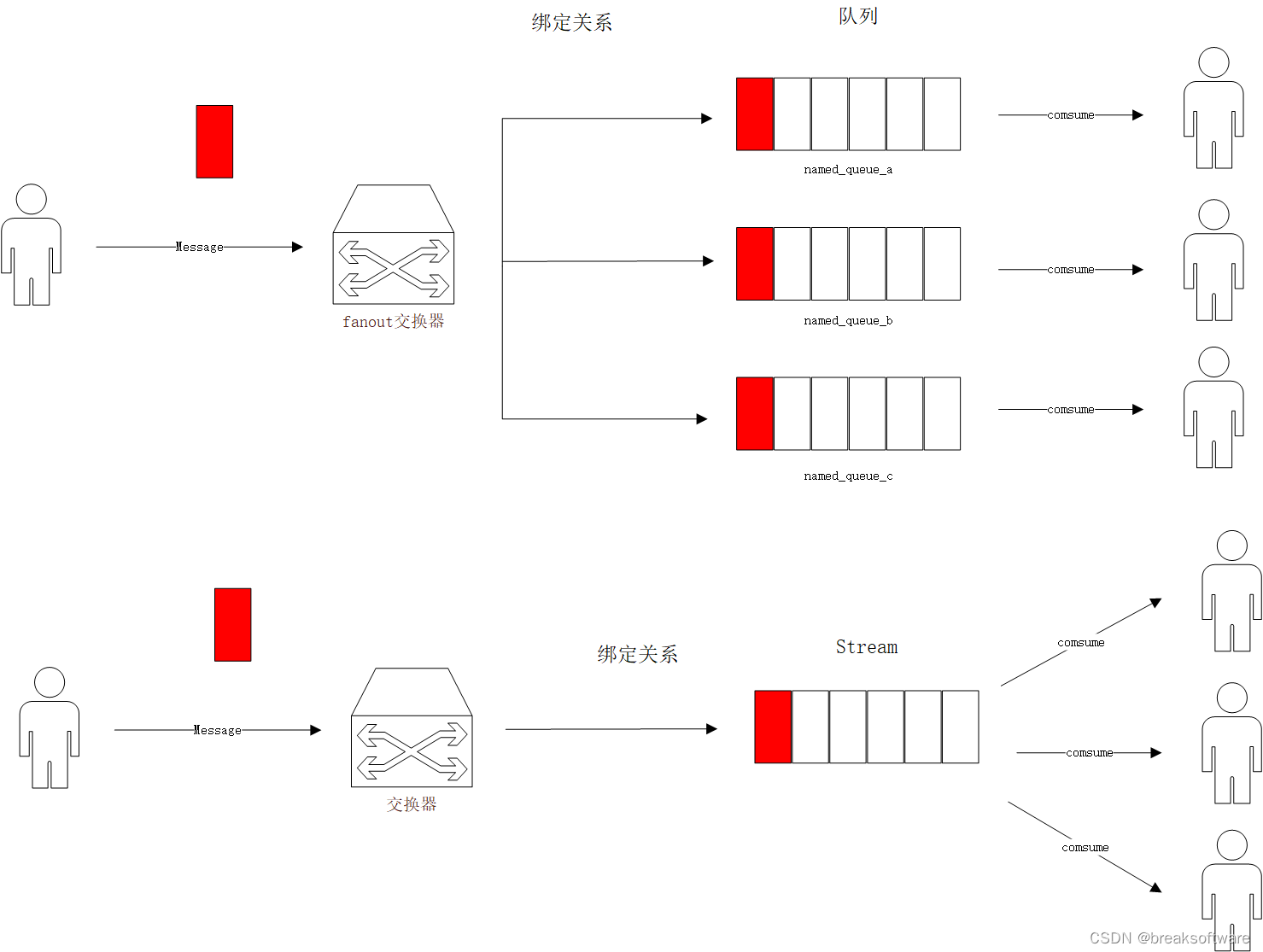大纲
- 什么是Stream队列
- 创建Stream
- 发布消息
- 消费
- 从第一条消息开始读取
- 从最后一条消息开始读取
- 从某个时间戳开始读取
- 从某个偏移量开始读取
- 样例
- 长度控制
- 长度控制
- 时间控制
- 服务端筛选消息
- 发布方设定过滤值
- 消费方设置服务端过滤,且要二次过滤
- 工程代码
- 参考资料
在 《RabbitMQ实践——搭建多人聊天服务》一文中,我们使用Stream队列存储了聊天室记录。但是每个进入聊天室的人不能读取历史消息,只能读取当前时间之后的消息。这是因为我们对读取逻辑做了特殊设置。本文我们将全面介绍Stream队列的使用。
什么是Stream队列
Stream队列保存了发布到其上所有未过期(时间或Size判断)的消息。消费者只可以读取该队列,但是不能让队列将已读消息删除。这样就可以保证相同配置的消费者可以读取到相同的消息。
鉴于它保留了未过期消息,所以非常适合需要读取历史消息的场景。
鉴于消费者不能让其删除已读消息,所以对于需要“扇出”大量相同消息的场景,可以使用一个Stream来替代Fanout交换器绑定多个相同消息队列的方案。这样即可以降低系统设计的复杂度,也会提升Rabbitmq服务效率。

创建Stream
下面代码会创建一个Stream。
action.queueDeclare(roomName, true, false, false,Collections.singletonMap("x-queue-type", "stream"));
需要注意的是:
- durable(第二个参数)只能设置为true。
- exclusive(第三个参数)只能设置为false
- autoDelete(第四个参数)只能设置为false。
下面完整代码,除了创建了Stream,还创建了交换器以及它们之间的绑定。
private void createChatRoom(String roomName) {rabbitTemplate.execute(action -> {action.exchangeDeclare(roomName, "fanout", false, true, null);action.queueDeclare(roomName, true, false, false,Collections.singletonMap("x-queue-type", "stream"));action.queueBind(roomName, roomName, "");return null;});}
发布消息
发布消息没什么特别,直接给交换器发送消息即可。
rabbitTemplate.send(roomName, "", msg);
消费
由于Stream中保存了所有未超时的消息,所以存在一个起始读取位置的问题。
还有两个比较特殊的情况需要注意:
- 不可以“自动应答”,即AutoACK只能是false。所以我们要对每条消息手工ack。
- 必须指定Qos。因为消费者需要手工应答,所以需要设置一个配额,这样可以保证过慢的服务减少获取消息,从而让服务分发消息更加合理。
一般常见的模式如下:
从第一条消息开始读取
“x-stream-offset"设置为"first”,就是从第一条消息开始读取。
channel.basicQos(100);
channel.basicConsume(roomName, false, username,false, true,Collections.singletonMap("x-stream-offset", "first"),(consumerTag, message) -> {// Your codechannel.basicAck(message.getEnvelope().getDeliveryTag(), false);},consumerTag -> { });
从最后一条消息开始读取
“x-stream-offset"设置为"last”,就是从第一条消息开始读取。
channel.basicQos(100);
channel.basicConsume(roomName, false, username,false, true,Collections.singletonMap("x-stream-offset", "last"),(consumerTag, message) -> {// Your codechannel.basicAck(message.getEnvelope().getDeliveryTag(), false);},consumerTag -> { });
从某个时间戳开始读取
Date timestamp = new Date(System.currentTimeMillis() - 60 * 60 * 1_000)
channel.basicQos(100);
channel.basicConsume(roomName, false, username,false, true,Collections.singletonMap("x-stream-offset", "last"),(consumerTag, message) -> {// Your codechannel.basicAck(message.getEnvelope().getDeliveryTag(), false);},consumerTag -> { });
从某个偏移量开始读取
channel.basicQos(100);
channel.basicConsume(roomName, false, username,false, true,Collections.singletonMap("x-stream-offset", offset),(consumerTag, message) -> {emitter.next(new String(message.getBody()));channel.basicAck(message.getEnvelope().getDeliveryTag(), false);},consumerTag -> { });
样例
延续《RabbitMQ实践——搭建多人聊天服务》的案例,上面几个场景的读取代码如下:
public Flux<String> getMessageFromFirst(String username, String roomName) {return Flux.create(emitter -> {rabbitTemplate.execute((ChannelCallback<Void>) channel -> {channel.basicQos(100);channel.basicConsume(roomName, false, username,false, true,Collections.singletonMap("x-stream-offset", "first"),(consumerTag, message) -> {emitter.next(new String(message.getBody()));channel.basicAck(message.getEnvelope().getDeliveryTag(), false);},consumerTag -> { });return null;});});}public Flux<String> getMessageFromLast(String username, String roomName) {return Flux.create(emitter -> {rabbitTemplate.execute((ChannelCallback<Void>) channel -> {channel.basicQos(100);channel.basicConsume(roomName, false, username,false, true,Collections.singletonMap("x-stream-offset", "last"),(consumerTag, message) -> {emitter.next(new String(message.getBody()));channel.basicAck(message.getEnvelope().getDeliveryTag(), false);},consumerTag -> { });return null;});});}public Flux<String> getMessageFromTimestamp(String username, String roomName, Date timestamp) {return Flux.create(emitter -> {rabbitTemplate.execute((ChannelCallback<Void>) channel -> {channel.basicQos(100);channel.basicConsume(roomName, false, username,false, true,Collections.singletonMap("x-stream-offset", timestamp),(consumerTag, message) -> {emitter.next(new String(message.getBody()));channel.basicAck(message.getEnvelope().getDeliveryTag(), false);},consumerTag -> { });return null;});});}public Flux<String> getMessageFromOffset(String username, String roomName, long offset) {return Flux.create(emitter -> {rabbitTemplate.execute((ChannelCallback<Void>) channel -> {channel.basicQos(100);channel.basicConsume(roomName, false, username,false, true,Collections.singletonMap("x-stream-offset", offset),(consumerTag, message) -> {emitter.next(new String(message.getBody()));channel.basicAck(message.getEnvelope().getDeliveryTag(), false);},consumerTag -> { });return null;});});}
长度控制
由于Stream并不会因为消费者而删除消息,导致其保存的消息数量一直在增加。所以需要通过一定的策略控制其大小。
长度控制
在创建Stream时,我们可以通过x-max-length-bytes设置其最大Size。这样如果Stream内容达到这个Size,最早的消息就会被Stream淘汰掉。
Map<String, Object> args = new HashMap<>();
args.put("x-max-length-bytes", maxSize);
args.put("x-queue-type", "stream");
action.queueDeclare(roomName, true, false, false, args);
时间控制
在创建Stream时,我们可以通过x-max-age设置消息的最长生命周期。超过这个时长的消息会被淘汰。它的取值可以是如下单位:Y, M, D, h, m, s。比如“1m”表示一分钟。
Map<String, Object> args = new HashMap<>();
args.put("x-max-age", ttl);
args.put("x-queue-type", "stream");
action.queueDeclare(roomName, true, false, false, args);
服务端筛选消息
如果消费者并不关系Stream中所有消息,它可以通过"x-stream-filter"来做过滤。这个过滤会发生在服务端,这样可以大大减轻消费者和服务端的压力。但是需要注意的是,服务端的过滤使用的是布隆过滤器,所以发送到消费者端的消息会包含不符合条件的消息,所以消费端需要做二次校验才可以使用。
发布方设定过滤值
channel.basicPublish("", // default exchange"my-stream",new AMQP.BasicProperties.Builder().headers(Collections.singletonMap("x-stream-filter-value", "california" // set filter value)).build(),body
);
消费方设置服务端过滤,且要二次过滤
channel.basicQos(100); // QoS must be specified
channel.basicConsume("my-stream",false,Collections.singletonMap("x-stream-filter", "california"), // set filter(consumerTag, message) -> {Map<String, Object> headers = message.getProperties().getHeaders();// there must be some client-side filter logicif ("california".equals(headers.get("x-stream-filter-value"))) {// message processing// ...}channel.basicAck(message.getEnvelope().getDeliveryTag(), false); // ack is required},consumerTag -> { });
工程代码
https://github.com/f304646673/RabbitMQDemo/tree/main/chat
参考资料
- https://www.rabbitmq.com/docs/streams
